BIOS -
BIOS is an acronym that stands for Basic Input/Output System. It is meant to control your product at a very low level. As of right now there are three regularly used BIOS formats (there are actually more than that but there are three common ones). These are the AMI (American Megatrends Incorporated), Award, and Phoenix. Of course with the introduction of the UEFI (Unified Extensible Firmware Interface) we now have a solid basis for the “BIOS” on new motherboards. This actually gets away from the term BIOS (Basic Input/Output System) and becomes more of a software interface. Each manufacturer will have their own take on how to implement this; some good, some not so good.
You can check out how Gigabyte has implemented the UEFI standard in their 3D BIOS in our video coverage below.
As you can see Gigabyte has made some nice improvements (at least the mouse is working properly now), but they still need to work on a few things.
Overclocking –
Overclocking is one of the fun parts of testing motherboards and CPUs (well really almost every component…). As Intel has developed their CPUs and Chipsets overclocking has become easier to accomplish for even a novice. CPUs and motherboards are designed with considerable headroom to allow for extra voltage and to handle the increase in speed. With Gigabyte this has become more and more of a priority. They have gone from a company that was only interested in getting stability to a company that is looking to get the most out of their products (and keeping them stable too). We saw this with our overclocking on the Z77X-UD5H. This was the only motherboard that was able to hit 4.8GHz using its Autotune functionality (and it was stable) while we had more success at 4.9GHz that just about any other board we have tested. Unfortunately 4.9GHz is still not fully stable so we dropped back to our 4.8GHz OC at 1.37 Volts. 
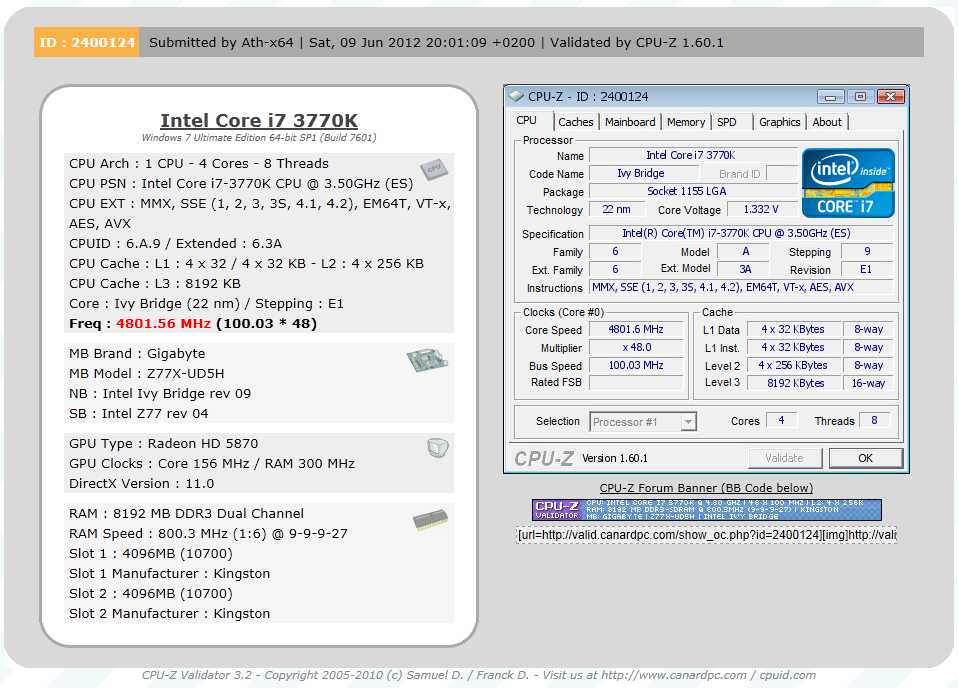
Of course overclocking is a picky subject. I can buy to identical CPUs from the store and they will not always perform the same way under stress. This is the same with motherboards, RAM and GPUs. So again it is important to keep in mind that our results represent a specific hardware configuration. Yours may be similar but will rarely be identical.
Overclocking Tools -
The main overclocking tool that you get with any Gigabyte motherboard is EasyTune6. This application is functional, but let’s face it Gigabyte needs to do some work on it to improve the look and usability of it. You can check out our video coverage of this and some of the other feature applications on the Z77X-UD5H below.
The Test System and Comments -
Our test system is built on an open bench. This has two effects on testing. First it allows us to see everything and also to setup and disassemble the test rigs quickly. Second it means that we cannot gauge the potential air flow found in a normal case. The air is pretty stagnant; some may say this is a great neutral testing method and it can be. However, it does mean that the temperature reading taken off of the components are not accurate to what an average consumer would see. This means that your thermal performance will vary from what we see here.
In addition to the raw performance numbers there are other items that go to make up a motherboard. One of these is always going to be ease of use and installation. As far as installation most of the products on the market today are going to be very simple to install. This is a good thing and in many ways is intended to bring more people into the DIY fold. I have to say that after showing people the advantages of building their own system, most will get hooked very quickly and almost never go back to pre-built boxes again. Gigabyte has been working to make things smoother for a while now and with their auto-installers you can get the drivers and utilities you need installed very quickly.
Unlike a few other companies Gigabyte has not started to force things down your throat like Chrome which is nice and will honestly attract more buyers (even those that already do custom installs).
Performance testing overview -
Our testing is a little different than most. We combine both synthetic and real-world applications to simulate the types of performance common to the individual products. For motherboards this means that we run roughly six synthetic tests and two real-world. We will be expanding the real-world testing in the near future. But there is more to performance than just the raw numbers. As there are multiple components and sub-components on a motherboard there each item can have a distinct impact on the way the product will perform once you get it in your system. It is important to note not only the actual results but what they mean to you as a potential consumer. We will try to give this information to you.
But we do not just cover the performance aspects that are measurable. We also talk about the components that might not have a direct benchmark. These are items like Audio Quality, ease of use and installation.
Section 1 Subsystems
Memory -
Memory performance is very important on a motherboard, especially when you have a CPU with multiple cores and threads. If you have slow memory your cores and threads can become starved for data to execute. To test memory performance we run both Sisoft’s SANDRA and AIDA64. These two combine to not only give us accurate numbers but to validate each other. For testing at stock speeds the memory is hard set to 1333MHz while overclocking testing is done at the highest stable speed for the voltage of 1.65v this is due to the different memory dividers for each CPU. As such, the memory speeds will vary greatly. This means that the overclocked numbers are a little misleading and while they can show a trend are really only included to show if a board has a problem with memory performance at high clockspeeds.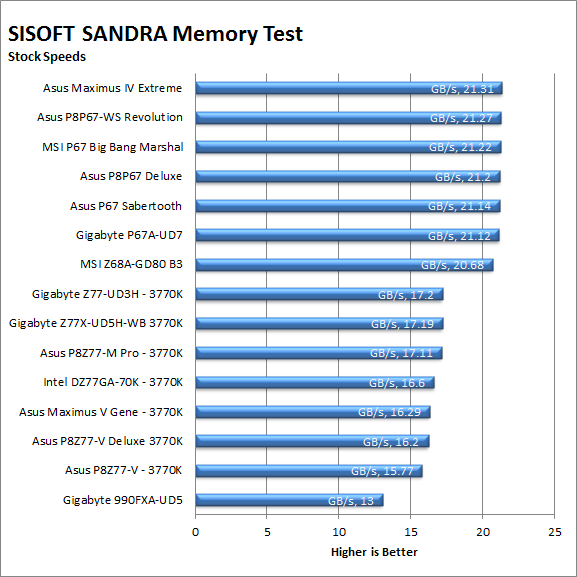
The Gigabyte Z77X-UD5H WB has solid memory bandwidth. We were not surprised here as we saw the same thing with Gigabyte’s Z77X-UD3H. Good memory bandwidth is going to get you improved performance when multi-tasking or when running applications that need to buffer a large amount of memory to work well. This is not just gaming or benchmarking, but also applications like Microsoft’s Outlook, Excel and other typical productivity applications. The performance here is a good sign that we will see good performance in many of our other tests… that is unless there is something else that stands in the way.
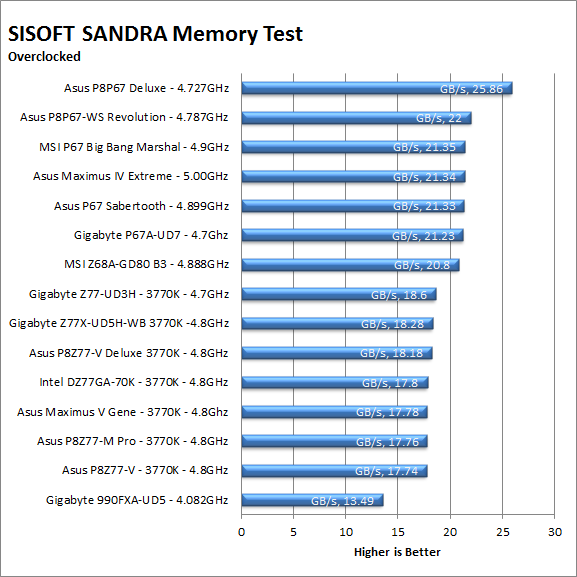
Drive performance -
Drive performance is also one of the major subsystems that goes to make up the performance of a motherboard. For our testing we use Sandra and AIDA64 again. We only test with single drives for each type of controller present on the motherboard (unless it is a professional product where we will use RIAD 5 and/or 10). We have also begun using a Seagate PS-110 USB 3 external HDD and a Kingston HyperX USB 3.0 Flash drive for our USB 3.0 performance. As a side note, we include the overclocked numbers here to make sure (again) that you are not going to see a major drop in performance due to minor instabilities at high clock speeds.
Drive speed is one of the things that can hurt good memory performance. The drive performance has to be much lower than the competition though for it to show an effect. For example of two boards have 18GB/s of memory bandwidth but one has slower HDD performance by 10MB/s then the second board can appear slower in many tests (and in actual usage). Although the difference between the top board and the Z77X-UD5H WiFi was not 10MB/s it is still enough for both SATA II and 3.0 to be of concern. 
USB 3.0 performance was right on target though with both our PS-110 and Kingston HyperX USB 3.0 drive performing well.
Power -
Power efficiency is another of those misnomers that we get caught up in. We hear about idle states and power gates. But what does that mean to you and I? On the surface having power management that reduces idle power sounds great and can be a benefit to someone that leaves their system on for long periods of time (and inactive) but how a system handles power under load and the delta between the two states is often more important than the idle power usage numbers. We use only P3 Kill A Watt instruments for measuring power.
| Power Draw iGPU Stock | Power Draw iGPU Overclocked |
 |
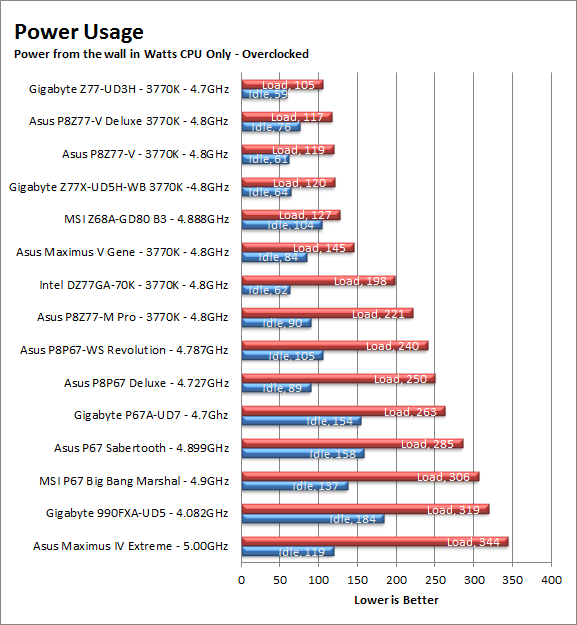 |
The Z77X-UD5H WiFi did very well in power efficiency when at stock speeds; in fact it was quite a bit ahead of the rest of the pack. We were surprised enough at this that we checked multiple times and also rechecked the settings in the BIOS to make sure they were where they were supposed to be. When overclocked and with our HD5870 in the system the Z77X-UD5H was not as efficient, but still did a pretty good job.
| Power Draw GPU Stock | Power Draw GPU Overclocked |
 |
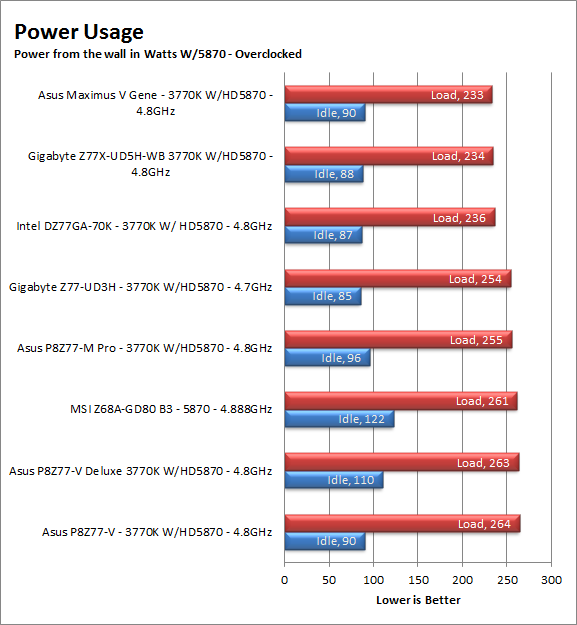 |
Cooling (Board Level) -
Board level cooling is an important factor in product performance and longevity. Components like the chipset, VRM modules and even capacitors need to be kept relatively cool to prevent failure. As these parts are made of silicon, they have a thermal breakdown threshold; or melting point. At that temperature the actual transistors built into chip will begin to deform and break down. Granted, the threshold is often very high, but you still need to make sure that components stay away from this level of heat for longer product life.
| Cooling iGPU Stock | Cooling iGPU Overclocked |
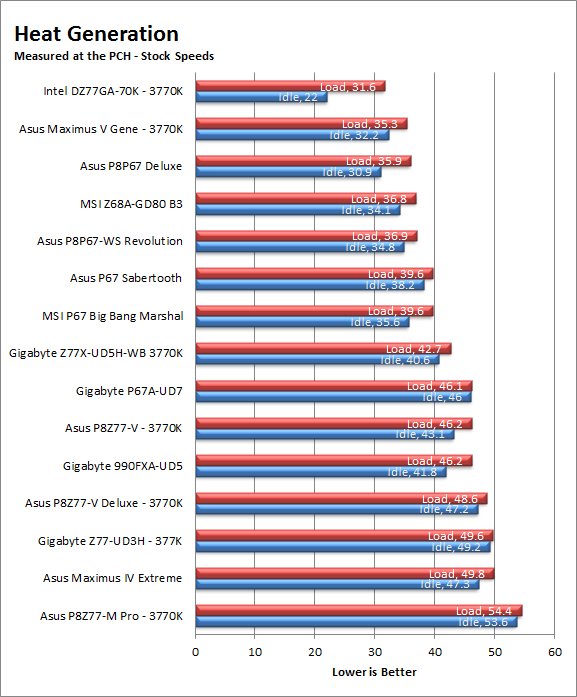 |
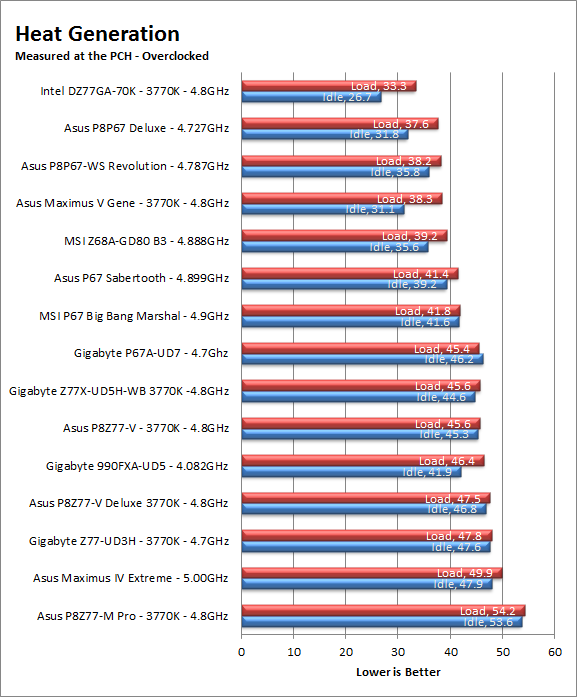 |
The Z77X-UD5H WiFi falls into our heat testing at right about the middle of the pack. This is for stock, overclocked, with add-in GPU and without. It was very interesting and does show us that while it might not be the coolest running board it can deal with the heat fairly well. This should give you good product life and overclocking potential (as you already saw).
| Heat Add-in GPU Stock | Heat Add-in GPu Overclocked |
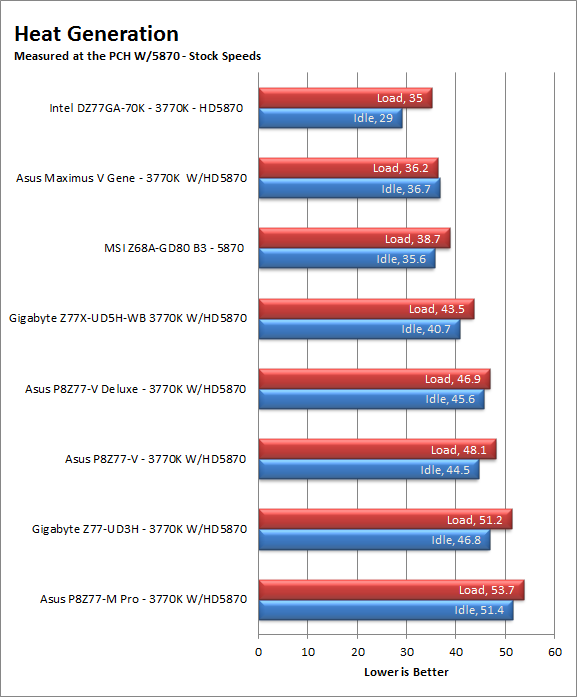 |
 |
Audio -
Audio is highly subjective. What we find pleasing may sound “off” to you. That is always going to the problem with testing audio; results will vary too widely depending on the tastes of the listener. However, there are ways of measuring the audio output with an objective ear. There is also the issue of audio causing performance issues in gaming and video playback. The reason this is a potential source of concern is that all onboard audio CODECs (Compression/Decompression) are CPU controlled. This means that while the audio chip controls the audio levels and effects of the audio the actual work is done on the CPU. Usually this will not be a problem with today’s powerful CPUs. Even the lower and consumer level products can handle high-end audio these days. But again there is the chance that a bad design or software will hinder your system and performance. On the other side the limits of board space, cost, etc will also prevent the level of audio quality you can get from an add-in board. We test all audio parts with three media types, Movie (DVD), MP3 Music, and Gaming. These are pushed to our Tec On model 55 Tube Amp to see if we can detect any signal issues in the reproduction. We briefly talked about the audio on the Z77X-UD5H WiFi when we covered the audio enhancement software (makes sense right?). While the built in audio on the UD5H WiFi is not going to wow any audiophiles it does a good job at keeping most people happy when it comes to audio performance. We found it to be good enough for most tasks and with THX Studio Pro and the EAX enhancements the gaming performance was a better than most.
Networking -
This one is something that is a requirement anymore. If you have a computer, the chances are good (like 99%) that you are also connected to high-speed internet. With this you need a good and solid LAN chip to make sure that your data flows properly out and back.
For networking performance the Z77X-UD5H WiFi was a very solid product. We had the Intel LAN controller for wired connectivity and an Atheros Wireless controller if you do not want to worry about cables. On top of that Gigabyte has included software (as we showed you a little bit earlier) that allows you to use your desktop like a fileserver, access point and more.
Section II - Performance Tests, Synthetic
In this section of testing we cover the synthetics. These are tests that run a scripted sequence of internal APIs or that use another installed application to perform a series of scripted events. They are great in that they can provide reproducible results across various platforms. On the down side, synthetic tests can be fooled with driver tweaks and optimizations. In some cases it is necessary to rename the .exe file to something generic to discover if this is the case. In any event when this is needed (when a test shows a drastic difference in performance over the renamed exe) we will note this and show both results for comparison.
PCMark7 -
PCMark7 is the latest general performance test from FutureMark. As each generation of this benchmark has evolved and developed we have watched them add more and more realistic tests to this suite. With this generation we find more media tests, (audio and video transcoding) moving of large files, multiple web page rendering, and much more (the even added DX10 gaming). We use the Overall Performance and Common Usage suites in our testing.
| PCMark7 iGPU Stock | PCMark7 iGPU Overclocked |
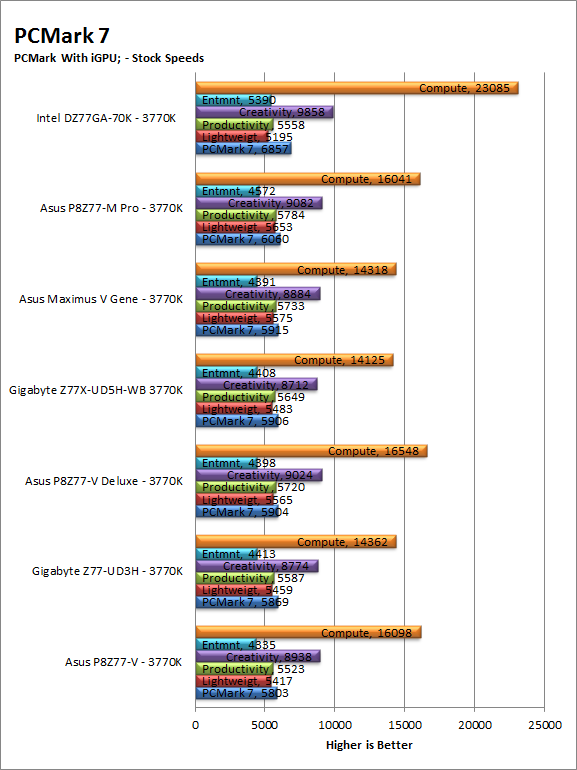 |
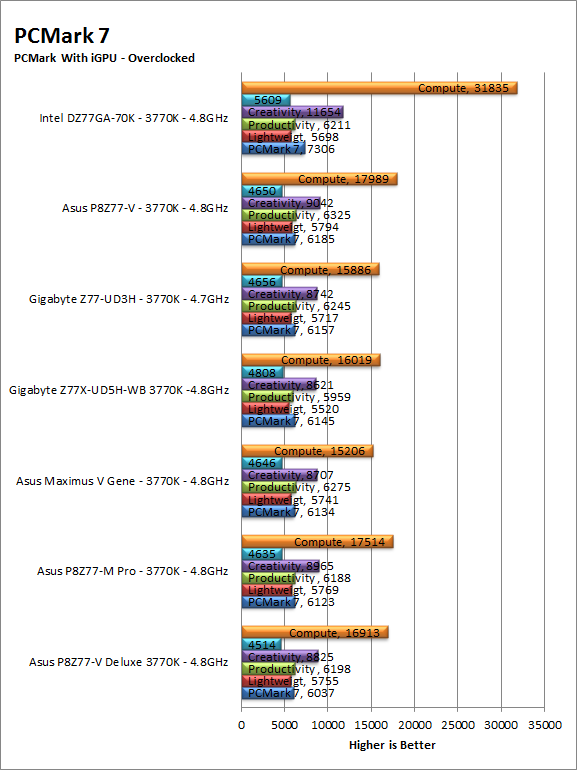 |
For PCMark7 we again found the Z77X-UD5H WiFi in the middle of the pack (or right around there) we were expecting a little more performance here, but as many of these tests are HDD reliant we were not overly surprised. Still the delta between the systems is very close so you would still get a good board here and it is unlikely that you would notice the performance difference unless you were trying to run multiple applications that required the HDD and Memory subsystems at the same time.
| PCMark7 Add-in GPU Stock | PCMark7 Add-in GPU Overclocked |
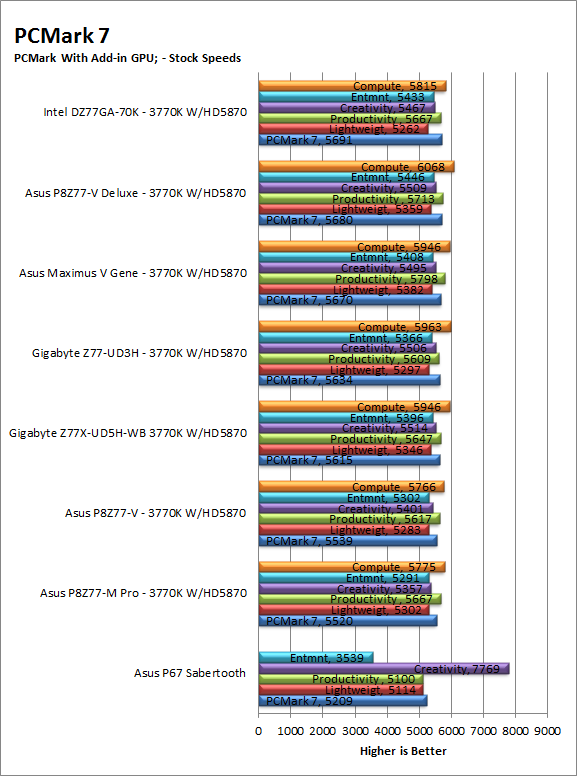 |
 |
3DMark 11 -
3DMark 11 is the other Futuremark test that we run on our motherboards. This test simulates the typical tasks that a GPU (and system) would have to perform to provide you with a good gaming experience. It is based on the DX9, DX10 and DX11 engines but can only be installed on Windows Vista or later. The suite of tests covers DX9, DX10, and of course DX11 rendering; it also covers AI computations and physics. That’s right I said Physics the latest version of 3DMark uses a Havok physics engine. This removes the advantage that nVidia had with 3DMark Vantage.
| 3DMark11 iGPU Stock | 3DMark11 iGPU Overclocked |
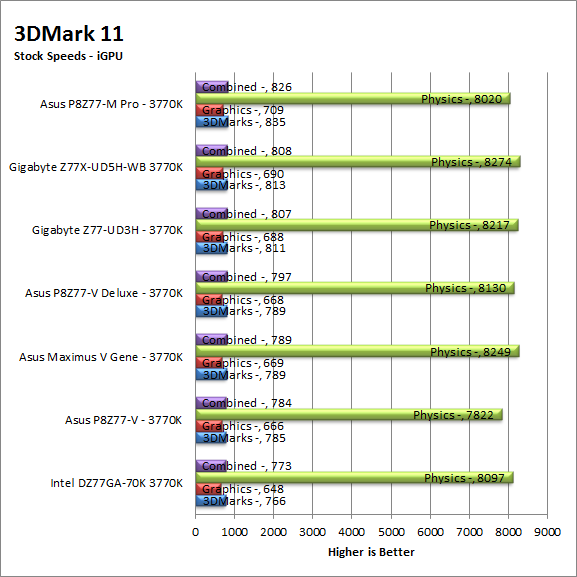 |
 |
For 3DMark11 the Gigabyte Z77X-UD5H WiFi was once again around the middle of the pack… that is with an add-in GPU. Surprisingly with the iGPU in the Core i7 3770k it was right at the top and had a maximum overclock of 1.5GHz on the GMA 4000. We were more than a little surprised by this but as we always say, 3DMark11 is a good starting point, but it is not the same as real gaming.
| 3DMark11 Add-in GPU Stock | 3DMark11 Add-in GPu Overclocked |
 |
 |
HyperPi 0.99b -
HyperPi is a front end application that allows you to easily run multiple instances of the SuperPi application. SuperPi, for those that are not familiar with it, is an application that measures the time it takes to calculate the number Pi out to as many as 32 million places. This calculation is then checked and run multiple times (up to 24 for a 32M run). This test stresses the CPU, Memory and HDD as data is handed off between the three. If there is a weak link, HyperPi will show it. For our testing we run the 32M test on as many cores (and threads) as the CPU has available. The slowest CPU time is then recorded. The blue bars indicate the slowest time while the red indicate the fastest.  At stock speeds the UD5H WiFi does well, although it was not as fast as we would have hoped; this most likely due to the HDD performance that we saw (the SATA 3.0 performance). We would also now expect to see rendering, and even transcoding be affected by this level of performance as they are all not much more than complex calculations which get buffered in memory and written back to the disk.
At stock speeds the UD5H WiFi does well, although it was not as fast as we would have hoped; this most likely due to the HDD performance that we saw (the SATA 3.0 performance). We would also now expect to see rendering, and even transcoding be affected by this level of performance as they are all not much more than complex calculations which get buffered in memory and written back to the disk.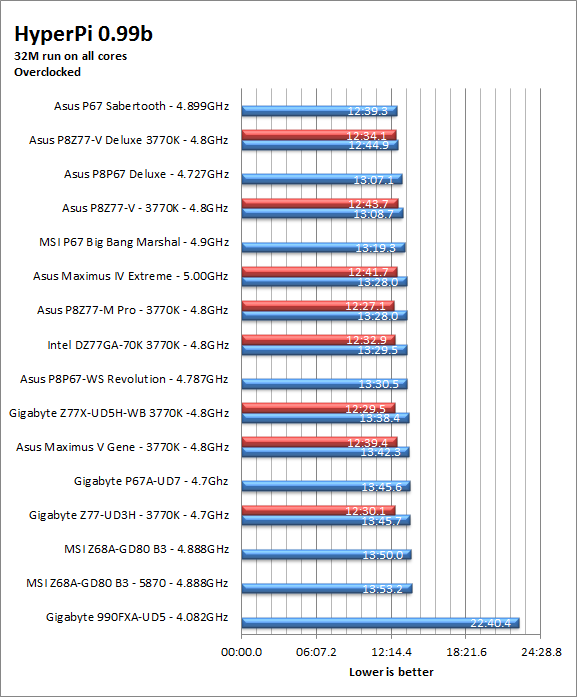
Cinebench R11.5 -
Cinebench R11.5 is the 11th release of Maxon’s rendering test. This test is based off of the Cinema 4D engine, which is one of the industry standard tools for digital animation. It is a powerful product with many different modules that can be “plugged” into it to increase its effectiveness. With Cinebench you get to see how your computer would do using this application. There are two tests; one tests the CPU’s ability to render an image across multiple cores or threads. The other tests your systems ability to handle OpenGL based rendering. 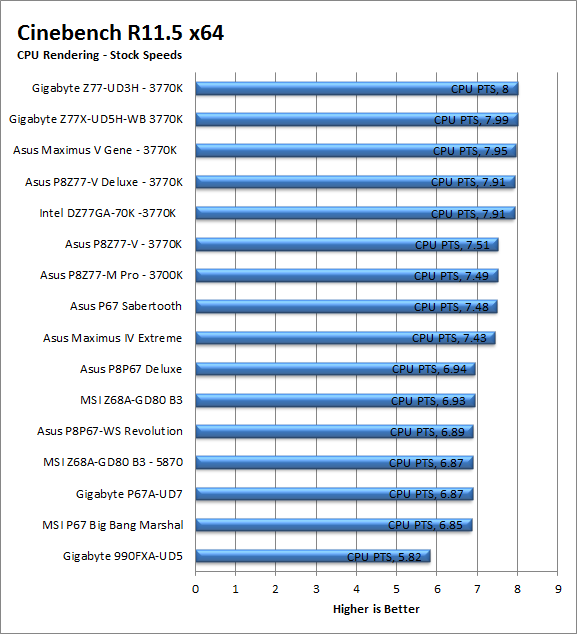
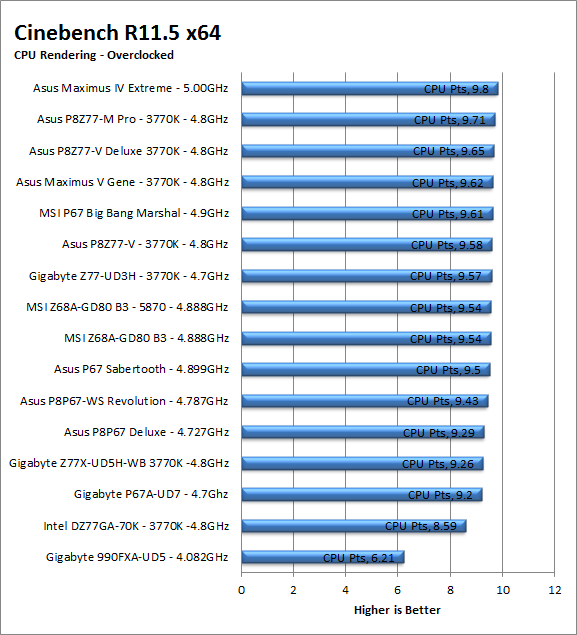
Both of Gigabyte’s Z77 boards do well with Cinebench at stock speeds for raw CPU rendering. However, when we start to push the CPU things drop off quite a bit and we find them toward the rear of the pack.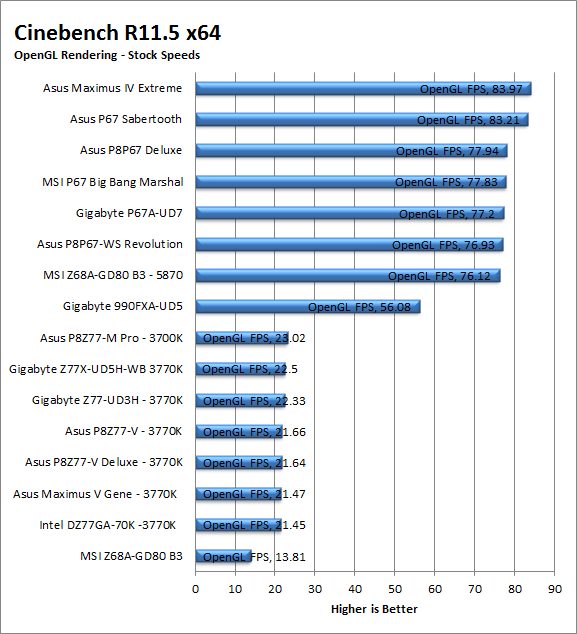
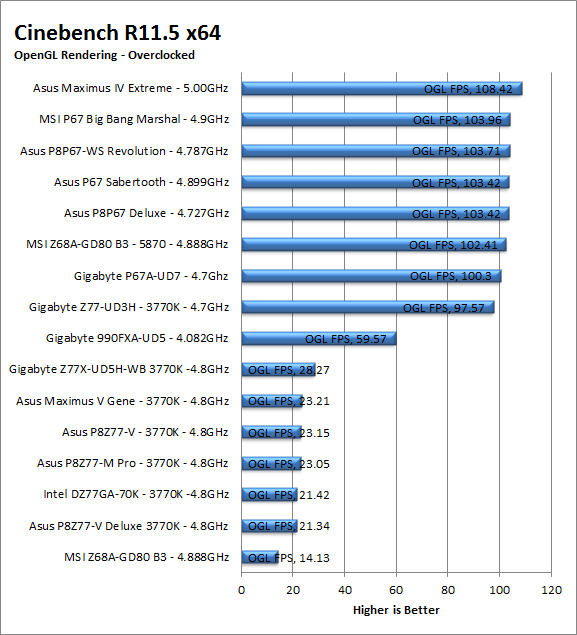
For OpenGL rendering the UD5H WiFi is right smack in the middle of things. So you should be able to get fairly decent performance out of the UD5H if you are looking to do some Maxon Cinema4D work, but it will not win you any records for performance.
Section III - Performance Tests, Real-World
Here we have two tests that are designed to put the performance of the motherboard and its subsystems to the test. Both require good CPU, Memory, HDD and even to a lesser extent audio and network performance. The two tests we chose were Lightwave 3D 9.6 and AutoGK 2.55. We will be adding at least one more real-world test to this battery in the near future, but for now these two cover quite a bit.
Lightwave 3D 9.6 x64 -
Lightwave is another industry standard application for 3D animation and rendering. It has a large tool base and the rendering engine is highly threaded (when using the right render model). This application is also capable of expanding to 4k resolutions as well as ray tracing for rending the light sources. For our testing we use frame 470 of the Pinball scene found in the LW 9 Content folder. This uses the newer perspective camera that is better suited to a multi-CPU/Core environment. This camera style also uses ray tracing and a much improved anti-aliasing method. Settings are shown below in the attached screen shot. Of course these are single frame renders and they are not a complete picture; for that you have to take into account the number of frames an average project would have. In a typical 30 second commercial you will have around 840 to 960 frames (at 28 – 32 FPS) this means that you have to multiply the time of a single frame by that number just to get a vague idea of how long that 30 seconds would take. This is because each frame will have a different render time based on complexity.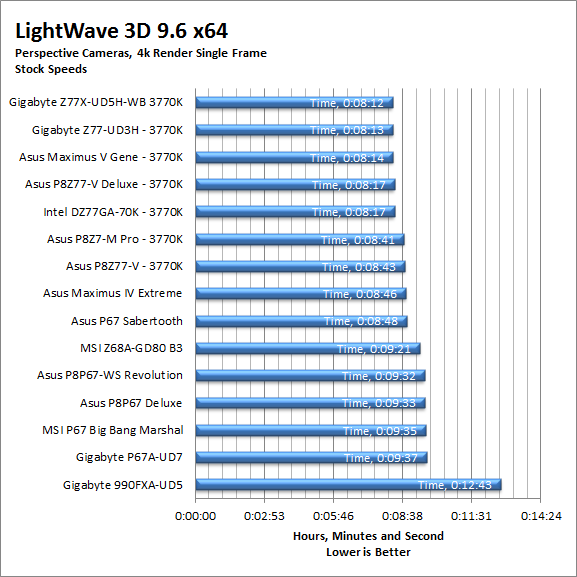
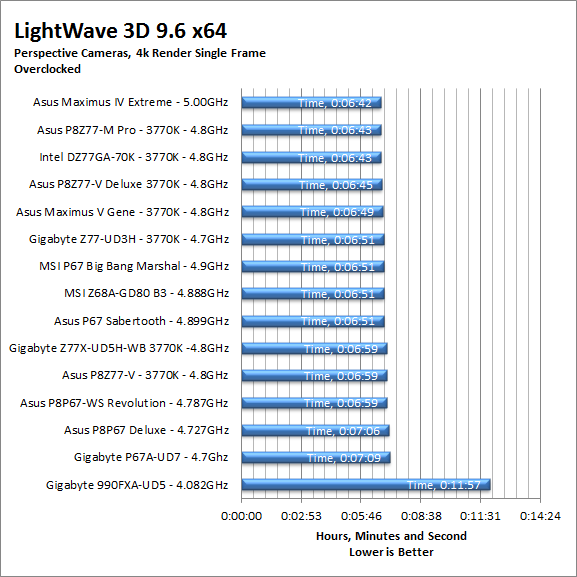
Once again both of the Gigabyte Z77 boards are at the top of the list… at stock speeds. When we try to push the system the drop back quite a bit; which is not usually the case. Still at least you know that you can get solid workstation performance from the UD5H WiFi if you need it, just make sure you keep things at default. 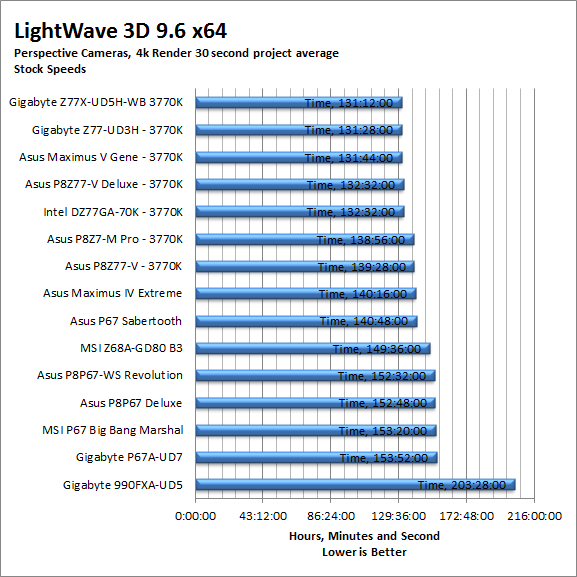
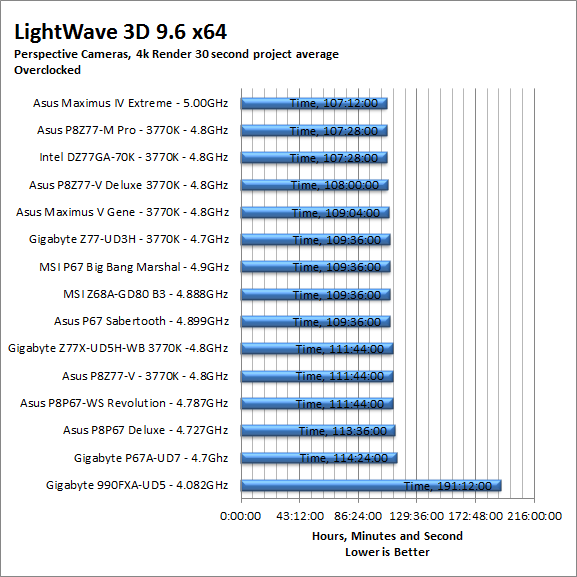
CyberLink Media Espresso 6.5 -
After having various issues with AutoGK and Intel CPUs with more than four cores we have changed our Media Encoding test to use Media Espresso from CyberLink. Although this new utility does not have the same ability to transfer directly from DVD it is still a good test to transfer different media types into a usable format for your iPad, iPod, or other media player. Our test involves using multiple (Six) 20 minute media files and transcoding them for an iPad. This gives us a very good indication of how well a motherboard can handle this type of work load.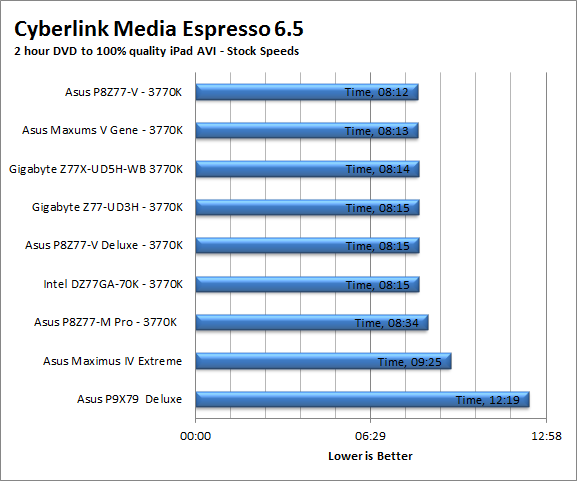
Here our performance is very different. As CyberLink’s Media Espresso has extensions to take full advantage of Intel’s Ivy and Sandy Bridge CPUs (and the GMA inside) we can see excellent performance here. When we overclocked the UD5H with its 1500MHz GPU speed we saw an even bigger jump in transcoding performance. Still, no matter which Z77 board you get you should expect some nice transcoding performance. 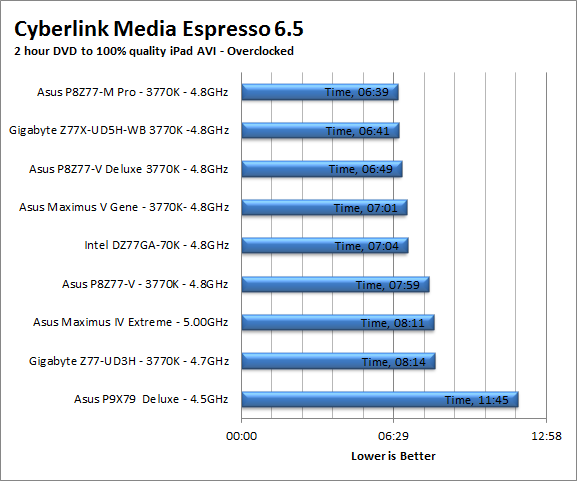
Section IV Performance – Gaming
Gaming as a test of motherboard performance is sort of a joke these days. The big player in the gaming arena is the GPU. Everyone but a few hardcore PR teams know this. However, it is important to run at least a few (one from each current DX version) to see if there are any issues with the combination of components on a motherboard. These are items like Audio lag, memory lag and of course problems with the PCIe lanes and signal traces. If there are issues in design, drivers or BIOS then you can have odd gaming performance. So without much more preamble let’s dive into the three games we currently use; Call of Duty Modern Warfare 2 for DX9 FarCry 2 for DX10 and Battlefield Bad Company 2 for DX11.
Call of Duty Modern Warfare 3 DX9 -
As the third installment in the Modern Warfare franchise you are picking up some old roles while adding a couple of new ones as well. The game play is almost identical to what you are used to in Modern Warfare 2 as are the graphical settings. The AI is a little different thought it is still similar to the bar fight style AI we like in the Call of Duty series. For our testing we run the first mission (Black Tuesday) from start to finish. Settings are shown below
 |
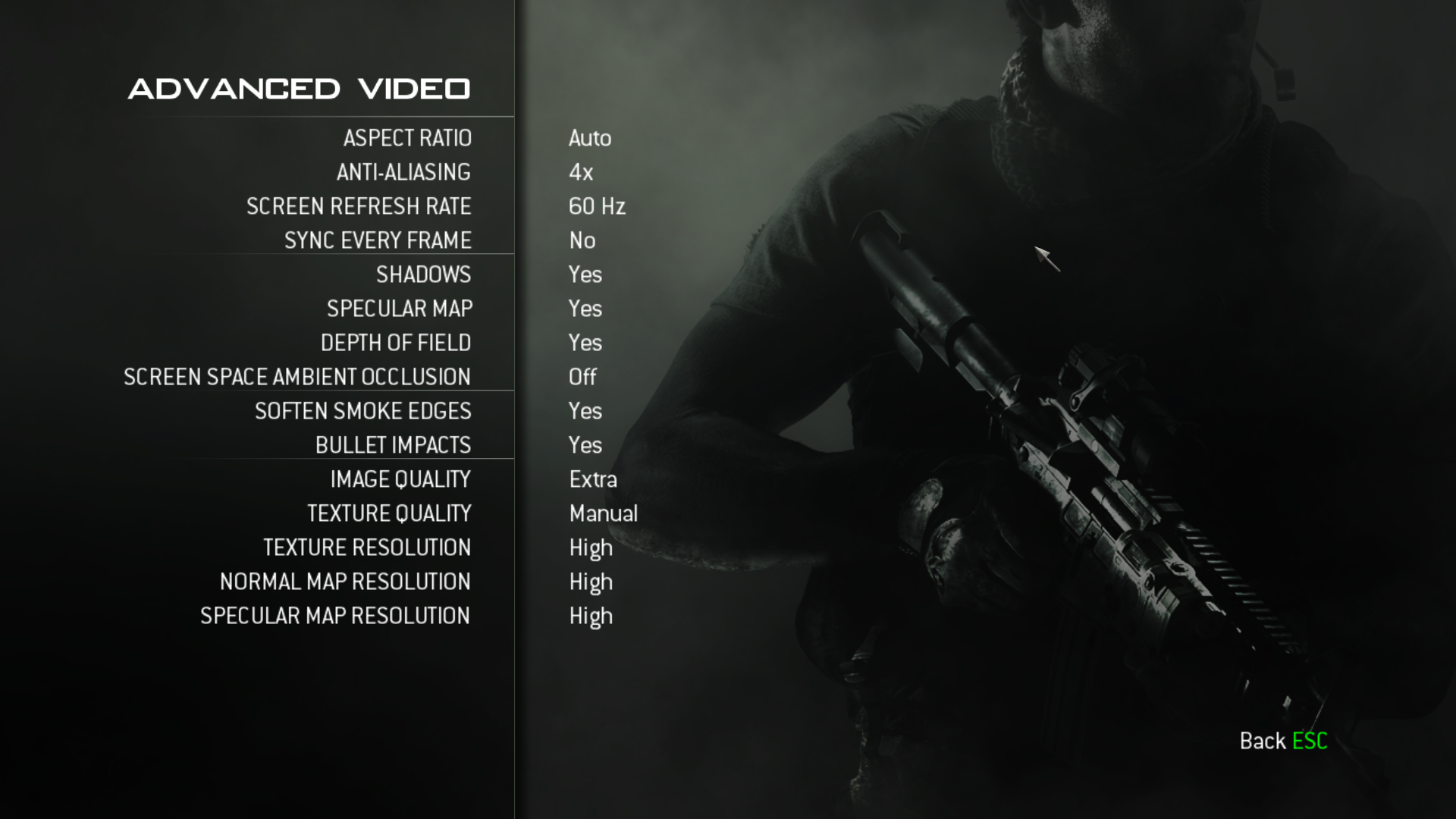 |
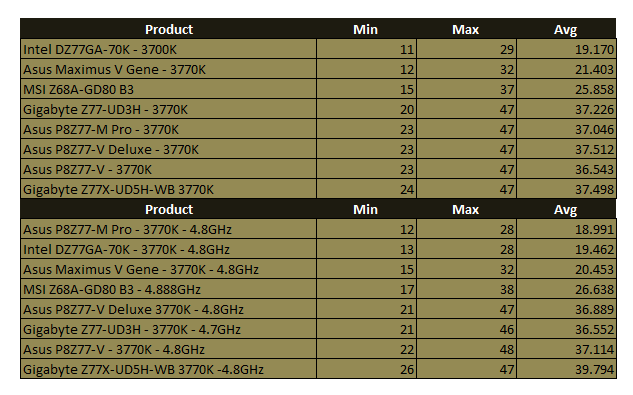

Although we include it (it is still a very popular game) Modern Warfare 3 is not all that hard on a GPU. As you can see, even the Intel GMA 4000 can handle it with all the eye candy on at high settings. We are in the process of determining if the GMA 4000 is capable of this level of performance in all DX9 games, or if this is simply something with the Modern Warfare render engine.
FarCry2 DX10 -
Although not one of my favorite games this tedious game does have some good graphics. The large sandbox style of the game lends to mission based play. The only problem is that the AI is rather low grade. Still the more CPU power the more the bad guys try to do. Over all the game was a little bit of a disappointment to play, but still not a bad DX10 representation. Our testing run starts right after you get your first mission to clean out the safe-house and ends after the hostage rescue. Settings and performance numbers are shown below.

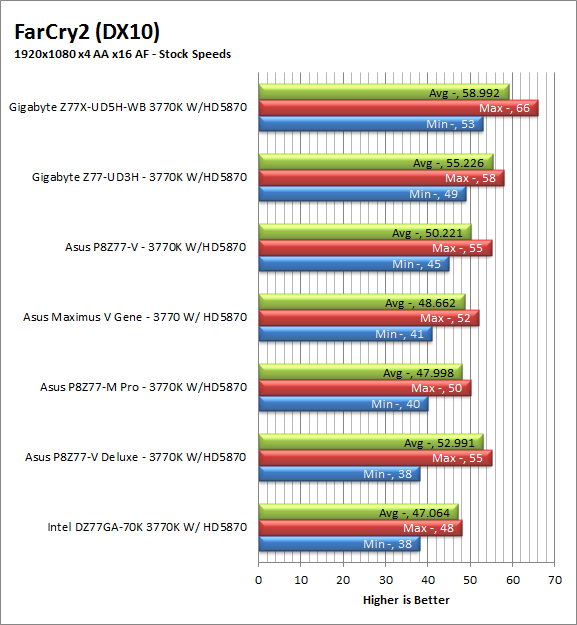
In FarCry2 things are a little more what we would expect from the GMA 4000, it was not anywhere near playable at native resolution (1920x1080). We also saw great performance with the Add-in HD5870 which means you should be able to get some good gaming performance out of the UD5H.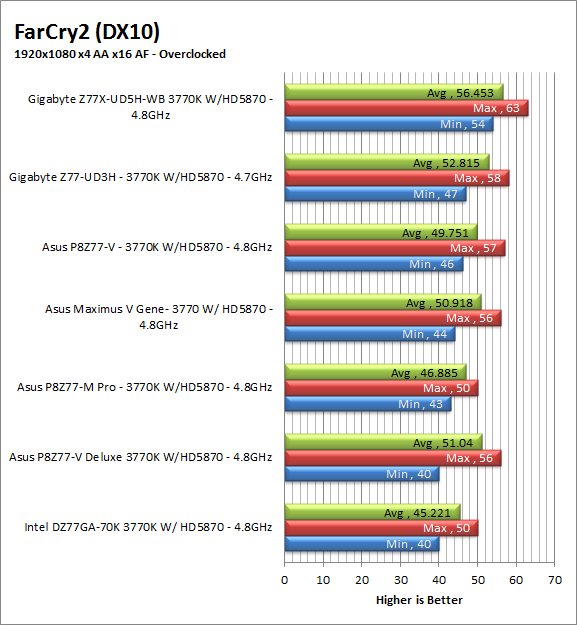
Crysis 2 DX11 –
Another sequel Crysis 2 follows up on two other Crysis games (making the title a little misleading). You take the role of a Force Recon Marine who is given a battle suit by a character named Profit (you will remember him from the other two Crysis games). From there you run around an Infected and Invaded New York City trying to survive and, of course, save the planet. For our testing we ran through the first “mission”. Settings are shown below.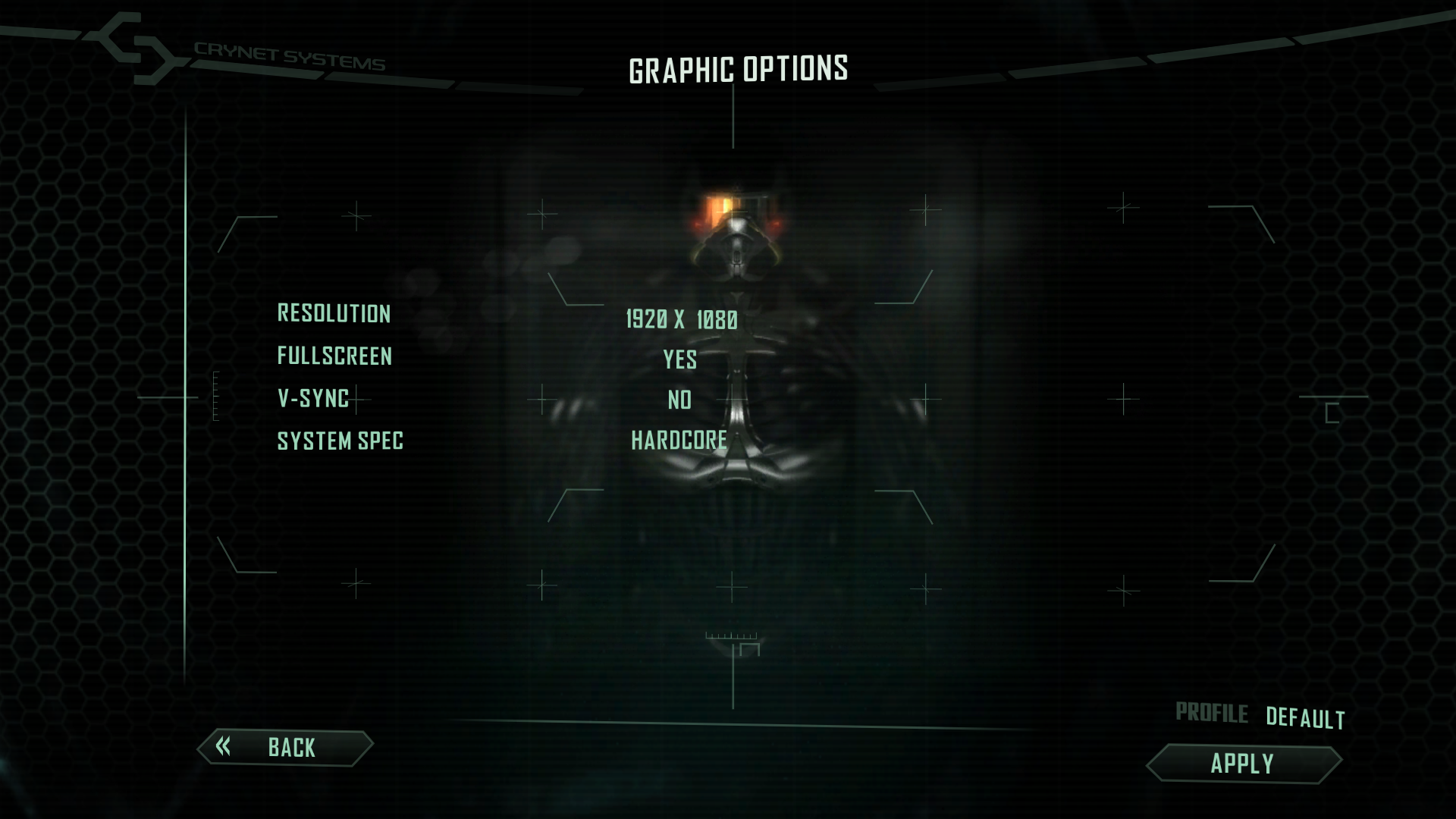
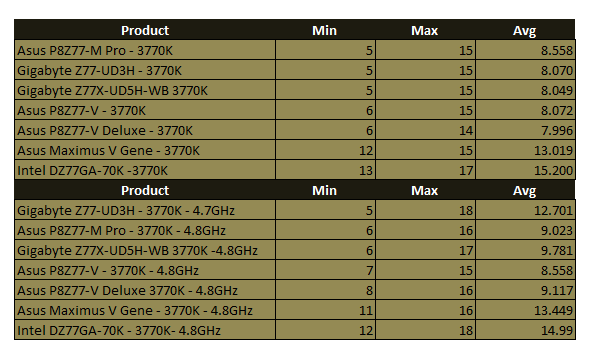

In Crysis 2… well we got what we expected here for the iGPU performance and were very impressed with the performance of the board with the HD5870 installed.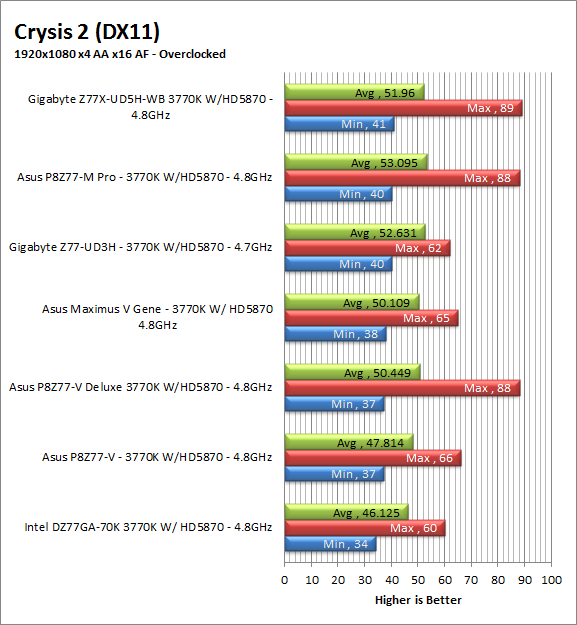
Gaming wrap-up -
The Gigabyte Z77X-UD5H WiFi does well at gaming. You would not be disappointed with it and we are not just talking about Frame Rates either. We had good level load times, good audio, and an overall good experience with the games we tested. We would expect the system performance to get even better with a PCIe Gen 3 GPU in the mix.
Value -
Value is another very subjective topic. What is expensive to some might be a deal to others. You can look at this topic in multiple ways. One is raw price and the other is what you get for the money. Each is accurate and both are correct ways to look at price/value. We tend to look at features, performance and real-property when we discuss value. However, we also take into account the raw cash cost of the item. At $210 the Z77X-UD5H WiFi is a good value if you simply compare things feature for feature with many other motherboards out there. When you add in the performance we see here, well... you are still getting a good deal, but there are some boards that are right around the same price range that can do better. The good news is that Gigabyte can correct most of the performance problems that we saw with the right BIOS update. If they can get this taken care of then the $210 price tag will not matter.
Conclusion -
As the Z77X-UD5H is meant to be at the upper end of Gigabyte’s line up we were a little disappointed with some of the performance we saw here. It is a good board, but it really felt a little immature in terms of the features and even the performance tuning. We know that Gigabyte can do much better than what we are seeing here though so we do expect them to correct the performance issues in the next BIOS revision. For right now, the UD5H is a solid product for general and workstation usage, but we just do not see if working as an overclocker’s or enthusiasts’ motherboard. If you are looking for a solid, stable board for your workstation or even a gaming box that you do not plan to overclock then the Gigabyte Z77X-UD5H WiFi is a board you will want to take a look at.
Discuss this in our Forum

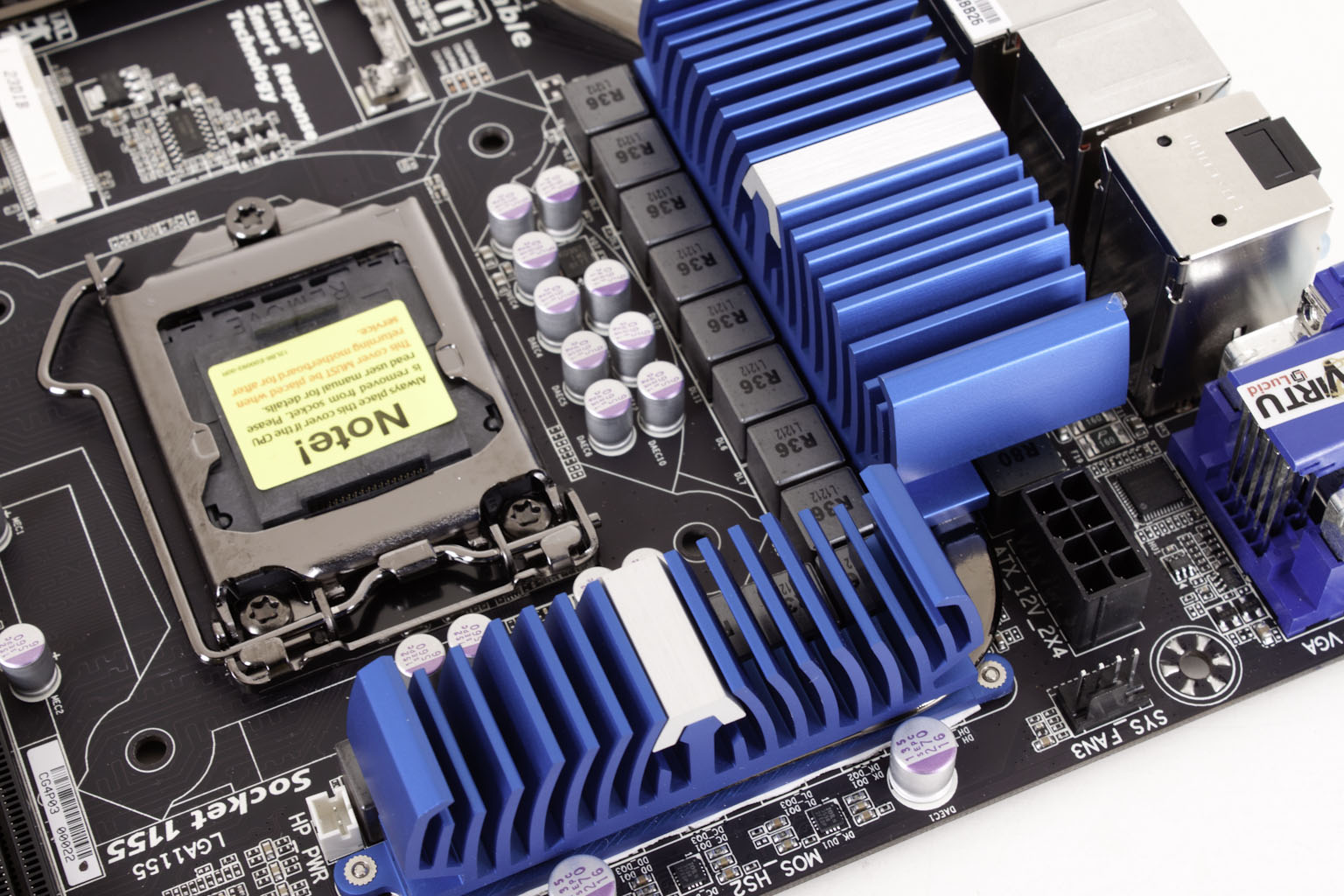 In our continuing coverage of the Gigabyte Z77X-UD5H WB we are moving into the performance side of things. Here is where it becomes difficult to differentiate between companies. The problem is that if you are testing Z77 Express based motherboards you are testing very similar platforms. It is only when you start adding in features to the mix that they separate. So the big deal here is how well do these products perform when you throw in all the advertised features (or at least as many as will work at once)? This is what we try to do with our performances testing. In our
In our continuing coverage of the Gigabyte Z77X-UD5H WB we are moving into the performance side of things. Here is where it becomes difficult to differentiate between companies. The problem is that if you are testing Z77 Express based motherboards you are testing very similar platforms. It is only when you start adding in features to the mix that they separate. So the big deal here is how well do these products perform when you throw in all the advertised features (or at least as many as will work at once)? This is what we try to do with our performances testing. In our 

